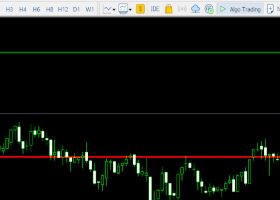Interest Rate Differential theory claims that exchange rate movements are determined by a nation's interest rate level.
According to the theory, countries with higher interest rates should experience their currency appreciate in value, and countries with lower interest rates should experience their currency depreciate in value.
When a country raises its interest rates, it's currency become more attractive to domestic and foreign investors so investment dollar will flock to that country due to higher yield for that country's currency.
How Interest Rates Move the Forex Market
Like current and future earnings prospects are the most important
factors to consider when trying to forecast the long term direction of a
stock, current and future interest rate prospects are the most
important factors to consider when trying to forecast the long term
direction of a currency. Because of this fact, currencies are highly
sensitive to any economic news that can affect the country's interest
rates, an important factor for traders of all time frames to understand.
When the central bank of a country raises interest rates this not only
affects the short term rate that they target, but the interest rates for
all types of debt instruments. If the central bank of a country raises
interest rates then debt instruments of all types are going to become
more attractive to investors, all else being equal. This not only means
that foreign investors are more likely to invest in the debt of that
country, but also that domestic investors are less likely to look
outside the country for higher yield, creating more demand for the debt
of that country and driving the value of the currency up, all else being
equal.
Conversely, when a central bank lowers interest rates, then interest
rates on all types of debt instruments for that country are going to be
less attractive to investors, all else being equal. This not only means
that both foreign and domestic investors are less likely to invest in
the debt of that country, but that they are also more likely to pull
money out to seek higher returns in other countries, creating less
demand for, and a greater market supply of that currency, and driving
its value down, all else being equal.
Once this is understood, it is next important to understand that foreign
investors are exposed to not only the potential profit or loss from
interest rate changes on the debt instrument they are investing in, but
also to profits and losses which result from fluctuations in the value
of that country's currency. This is an important concept to understand,
as it generally will work to increase the profits for investors when
interest rates increase, as the increase in the value of the currency is
realized when they sell the investment and convert back into their home
country's currency. This gives the foreign investor that much extra
return on their investment, and that much extra incentive to invest when
interest rates rise, driving the value of the currency up further all
else being equal.
Conversely when interest rates decrease, there will be less demand for
the debt instruments of a country not only because of the lower yield to
investors, but also because of the decrease in the value of the
currency that normally comes with a decrease in interest rates. The
additional whammy of a loss to the foreign investor from the currency
conversion that results as part of the investment, further incitivizes
them to put their money elsewhere, decreasing the value of the currency
further, all else being equal.


![[$9,496] in 5 Days Using 'Supply Demand EA ProBot' (Live Results) [$9,496] in 5 Days Using 'Supply Demand EA ProBot' (Live Results)](https://c.mql5.com/6/965/splash-preview-761070-1740062258.png)
